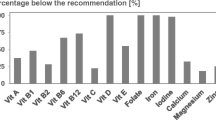Abstract
Purpose
This prospective study was carried out in order to investigate changes in nutritional intake during pregnancy with regard to caloric intake and macronutrient composition in normal-weight pregnant women.
Methods
Using food scales, 32 healthy pregnant women estimated their food intake over a period of 2 days at gestational week 16, 22, 30, 36 and, in addition, 6 weeks after delivery. The recorded food logs were analyzed with respect to caloric intake and macronutrient composition.
Results
The women’s age was averaged 29.6 ± 4.5 years, and the mean pre-pregnancy BMI was 22.4 ± 2.5 kg/m2. Mean weight gain was 16.5 ± 4.5 kg. On average, birth took place during the 40th week of gestation, with the babies having a mean birth weight of 3,515 ± 406 g. Caloric intake during the gestation period and post-partum showed no statistically significant changes and added up 9,237 ± 1,876 kJ/day during the 16th week of gestation, 9,496 ± 2,437 kJ/day during the 22nd, 9,073 ± 1,863 kJ/day during the 30th, 9,525 ± 2,135 kJ/day during the 36th week and 8,445 ± 2,160 kJ/day 6 weeks after delivery. No significant changes were observed in the composition of macronutrients during the pregnancy. The daily composition of macronutrients was as follows: carbohydrates 281 ± 57 g/day (51.7%), fat 86 ± 16 g/day (35.8%) and protein 75 ± 13 g/day (13.9%). However, we observed a decrease in carbohydrate intake of 239 ± 72 g/day (48%) after birth.
Conclusions
Healthy pregnant women showed no significant changes in their caloric intake or nutritional profiles. Performed with an accurate measurement, this prospective study shows that healthy pregnant require neither increased caloric intake nor a change in macronutrient composition.


Similar content being viewed by others
References
Durnin JV, McKillop FM, Grant S, Fitzgerald G (1985) Is nutritional status endangered by virtually no extra intake during pregnancy? Lancet 2:823–825
Prentice AM, Goldberg GR (2000) Energy adaptations in human pregnancy: Limits and long-term consequences. Am J Clin Nutr 71:1226–1237
Butte NF, Wong WW, Treuth MS, Ellis KJ, Smith EO (2004) Energy requirements during pregnancy based on total energy expenditure and energy disposition. Am J Clin Nutr 79:1078–1087
Prentice AM, Spaaij CJK, Goldberg GR et al (1996) Energy requirements of pregnant and lactating women. Eur J Clin Nutr 50:82–111
Durnin JV, McKillop FM, Grant S, Fitzgerald G (1987) Energy requirements of pregnancy in Scotland. Lancet 2:897–900
van Raaij JM, Vermaat-Miedema SH, Schonk CM, Peek ME, Hautvast JG (1987) Energy requirements of pregnancy in the Netherlands. Lancet 2:953–955
Durnin JV (1991) Energy requirements of pregnancy. Diabetes 40:152–156
Kopp-Hoolihan LE, van Loan MD, Wong WW, King JC (1999) Longitudinal assessment of energy balance in well-nourished, pregnant women. Am J Clin Nutr 69:697–704
Poppit SD, Prentice AM, Goldberg GR, Whitehead RG (1994) Energy-sparing strategies to protect human fetal growth. Am J Obstet Gynecol 171:118–125
Picciano MF (2003) Pregnancy and lactation: physical adjustments, nutritional requirements and the role of dietary supplements. J Nutr 133:1997–2002
DACH Referenzwerte für Nährstoffzufuhr (2001) 1. Auflage, DGE, ÖGE, SGE, SVE
Institute of Medicine (2002/2005) Dietary reference intakes (DRIs) for energy, carbohydrate, fiber, fat, fatty acids, cholesterol, protein and amino acids
Souci SW, Fachmann W, Kraut H (1989/1990) Food composition and nutrition tables. Wissenschaftliche Verlagsgesellschaft, Stuttgart
Institute of Medicine (1990) Nutrition during pregnancy: weight gain and nutritional supplements. National Academy Press, Washington, DC
Moore VM, Davies MJ, Willson KJ, Worsley A, Robinson JS (2004) Dietary composition of pregnant women is related to size of the baby at birth. J Nutr 134:1820–1826
Mathews F, Yudkin P, Neil A (1999) Influence of maternal nutrition on outcome of pregnancy: prospective cohort study. Br Med J 319:339–343
Godfrey K, Robinson S, Barker DJP, Osmond C (1996) Maternal nutrition in early and late pregnancy in relation to placental and fetal growth. Br Med J 312:410–414
Conflict of interest statement
We declare that we have no conflict of interest.
Author information
Authors and Affiliations
Corresponding author
Rights and permissions
About this article
Cite this article
Talai Rad, N., Ritterath, C., Siegmund, T. et al. Longitudinal analysis of changes in energy intake and macronutrient composition during pregnancy and 6 weeks post-partum. Arch Gynecol Obstet 283, 185–190 (2011). https://doi.org/10.1007/s00404-009-1328-1
Received:
Accepted:
Published:
Issue Date:
DOI: https://doi.org/10.1007/s00404-009-1328-1




